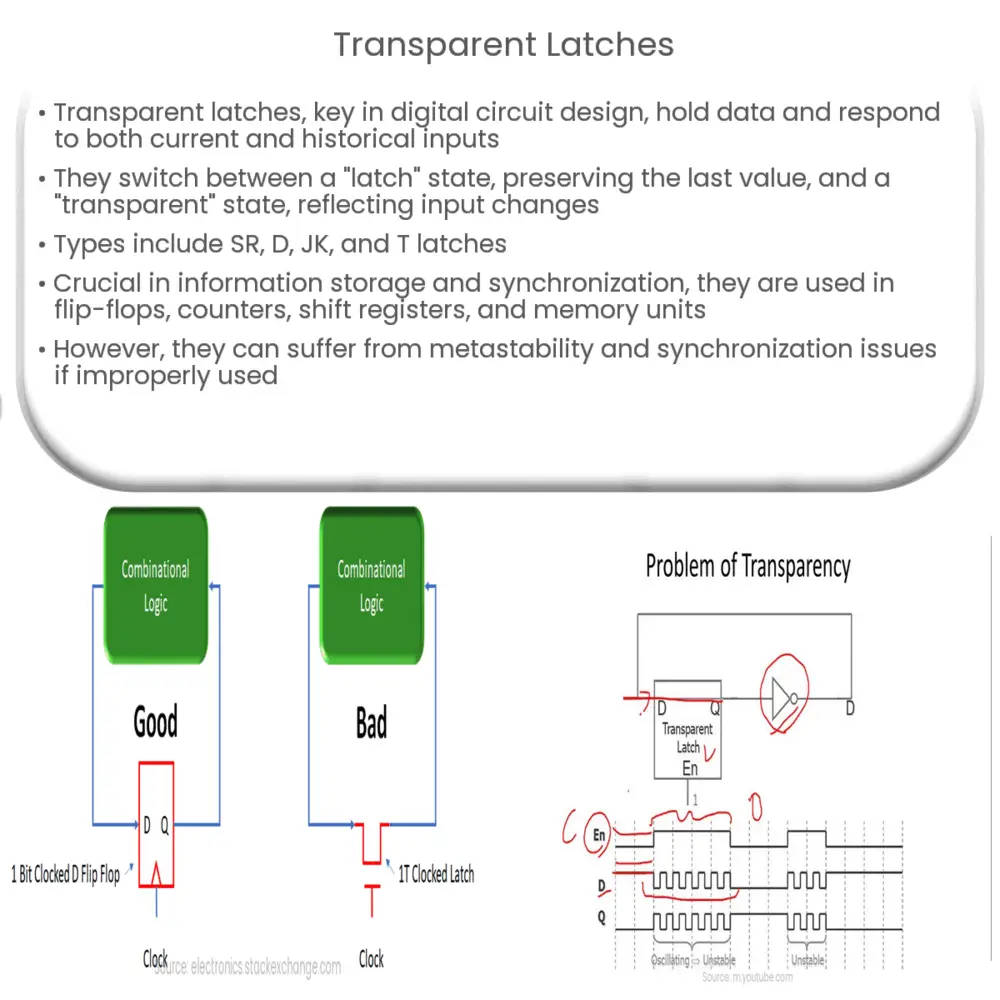Explore the essentials of Transparent Latches, their types, functionality in digital circuits, limitations, and significance in system design.

Introduction to Transparent Latches
Transparent Latches, often simply referred to as latches, are fundamental building blocks in digital circuit design. They are a type of sequential logic circuit, which means they respond not only to current inputs but also to a history of inputs. This is in contrast to combinational logic circuits, which only respond to current inputs. Transparent latches hold or “latch” data, allowing it to be used at a later point in the circuit’s operation.
The Functionality of Transparent Latches
The basic operation of a transparent latch revolves around two primary states, the “latch” state, and the “transparent” state. When the latch is in the transparent state, changes to the input directly affect the output. However, when the latch is in the latch state, the input is disconnected from the output, hence the output retains or “latches” onto the last value before the disconnect.
Types of Latches
- SR Latch: This is the simplest type of latch which consists of two cross-coupled NOR gates or two cross-coupled NAND gates. SR stands for Set-Reset.
- D Latch: Also known as a data latch, it is a modification of the SR latch which ensures that the set and reset inputs are never simultaneously active.
- JK Latch: This latch overcomes the undefined state in the SR latch by using the feedback configuration. It introduces a memory function to the latch.
- T Latch: Known as the Toggle latch, it is a modified version of the JK latch. It toggles the output when the input is triggered.
Usage of Transparent Latches in Digital Circuits
In digital circuits, latches play an essential role in storing information and synchronizing the timing of various operations. They serve as the basic storage elements in structures like flip-flops, counters, shift registers, and memory units.
Latches are often used in electronic systems that require data storage or the synchronization of multiple signals or actions. For example, they can be found in computer systems where they store binary information and allow that information to be processed at controlled times.
Moreover, they are used in debouncing circuits, which are designed to eliminate unwanted noise signals. They are also used in latch-based memories or DRAM (Dynamic Random Access Memory).
Transparent Latch as Data Stabilizers
Transparent latches are employed in data transmission and processing systems as stabilizing elements. This is crucial when signals are sent over long distances or are required to traverse complex circuits. The latch ensures that even if the signal becomes degraded, the original data can still be recovered at the output. The signal is thus ‘cleaned’ and re-transmitted with its original strength and clarity.
Designing with Transparent Latches
When designing digital systems using latches, it is important to understand the timing characteristics and requirements of the system to avoid any issues like glitches or race conditions. For instance, understanding when the latch is transparent or opaque in the clock cycle is crucial to avoid data corruption. Likewise, the timing of changes to the input data relative to the clock signal is also critical.
Limitations of Transparent Latches
Despite their advantages, transparent latches have certain limitations. One of the most significant is the possibility of metastability, a state in which it’s uncertain whether a latch will settle to a logic ‘1’ or ‘0’. This can occur when the data input changes near the active edge of the clock signal, leading to possible data corruption.
Moreover, the number of latches that can be cascaded together is limited due to propagation delay, which is the time it takes for an input change to reflect at the output. Excessive cascading of latches can lead to data synchronization issues in a digital system.
Conclusion
In conclusion, transparent latches are pivotal components in digital circuits. Their unique characteristic of maintaining data integrity and their versatile usage in synchronization, data storage, and signal stabilization make them an essential element in many digital systems. However, as with any component, understanding their limitations and proper usage is crucial when incorporating them into any system design. As technology continues to evolve, these fundamental building blocks of digital electronics will likely remain instrumental in shaping the future of digital systems and technologies.

